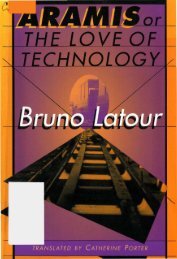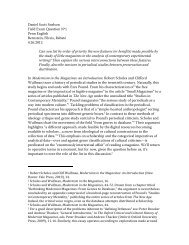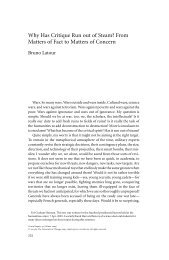The Exploit: A Theory of Networks - asounder
The Exploit: A Theory of Networks - asounder
The Exploit: A Theory of Networks - asounder
You also want an ePaper? Increase the reach of your titles
YUMPU automatically turns print PDFs into web optimized ePapers that Google loves.
132 Edges<br />
criminal cases, psychological pr<strong>of</strong>iling has given way to DNA matching.<br />
In consumer products, commodity logistics have given way to<br />
RFID databases. Genomics are the universal identification <strong>of</strong> life in<br />
the abstract; biometrics are the universal identification <strong>of</strong> life in the<br />
particular; collaborative filters are the universal identification <strong>of</strong> life<br />
in the relational.<br />
<strong>The</strong> twentieth century will be remembered as the last time there<br />
existed nonmedia. In the future there will be a coincidence between<br />
happening and storage. After universal standards <strong>of</strong> identification are<br />
agreed on, real - time tracking technologies will increase exponentially,<br />
such that almost any space will be iteratively archived over time using<br />
Agre’s “grammars <strong>of</strong> action.” Space will become rewindable, fully simulated<br />
at all available time codes. Henceforth the lived environment<br />
will be divided into identifiable zones and nonidentifiable zones, and<br />
the nonidentifiables will be the shadowy new criminal classes.<br />
RFC001b: BmTP<br />
A technological infrastructure for enabling an authentic integration<br />
<strong>of</strong> biological and informatic networks already exists. In separate steps,<br />
it occurs daily in molecular biology labs. <strong>The</strong> technologies <strong>of</strong> genomics<br />
enable the automation <strong>of</strong> the sequencing <strong>of</strong> DNA from any<br />
biological sample, from blood, to test-tube DNA, to a computer file <strong>of</strong><br />
text sequence, to an online genome database. And conversely, researchers<br />
regularly access databases such as GenBank for their research<br />
on in vitro molecules, enabling them to synthesize DNA sequences<br />
for further research. In other words, there already exists, in many<br />
standard molecular biology labs, the technology for encoding, recoding,<br />
and decoding biological information. From DNA in a test tube<br />
to an online database, and back into a test tube. In vivo, in vitro, in<br />
silico. What enables such passages is the particular character <strong>of</strong> the<br />
networks stitching those cells, enzymes, and DNA sequences together.<br />
At least two networks are in play here: the informatic network <strong>of</strong> the<br />
Internet, which enables uploading and downloading <strong>of</strong> biological information<br />
and brings together databases, search engines, and specialized<br />
hardware. <strong>The</strong>n there is the biological network <strong>of</strong> gene expression<br />
that occurs in between DNA and a panoply <strong>of</strong> regulatory









